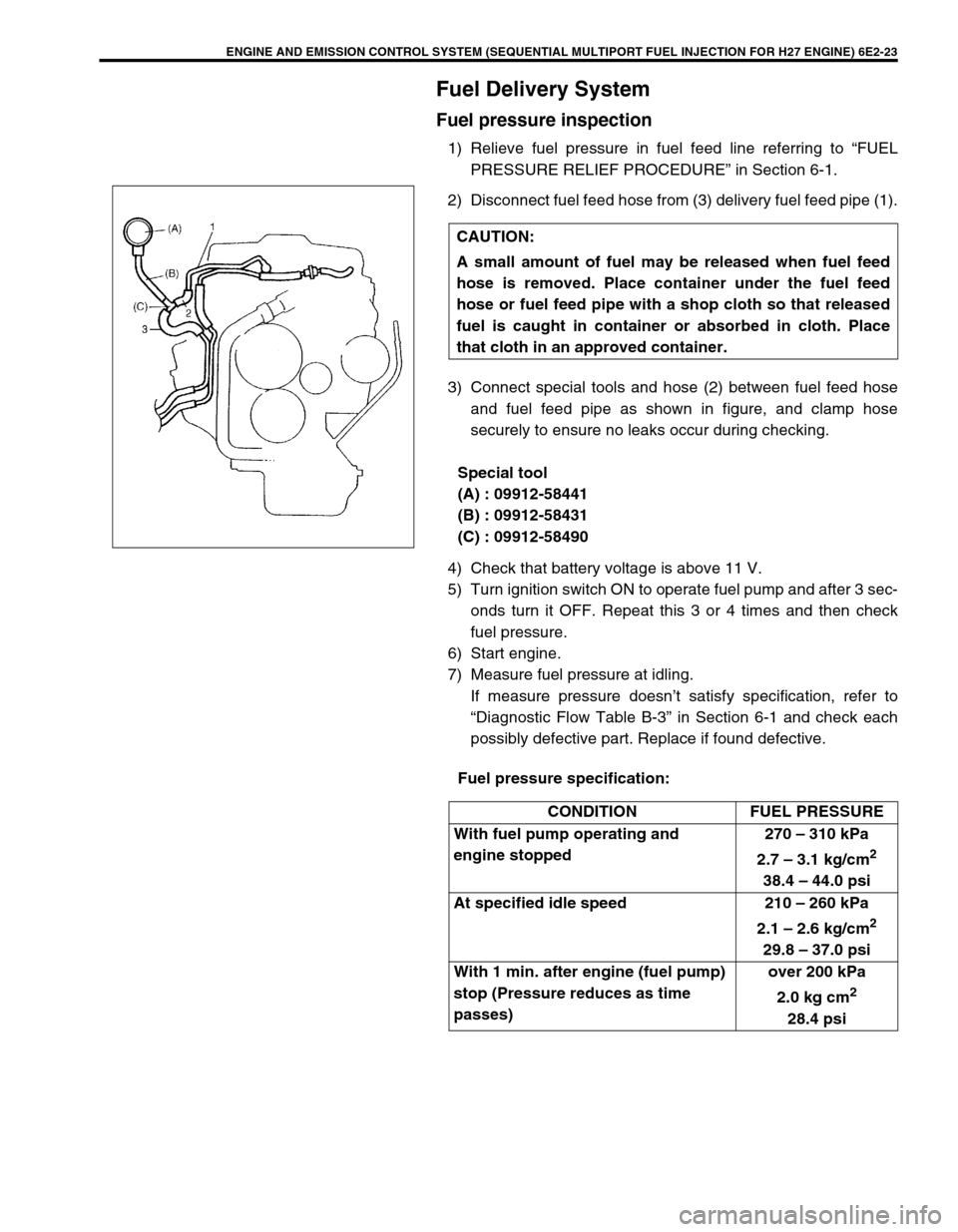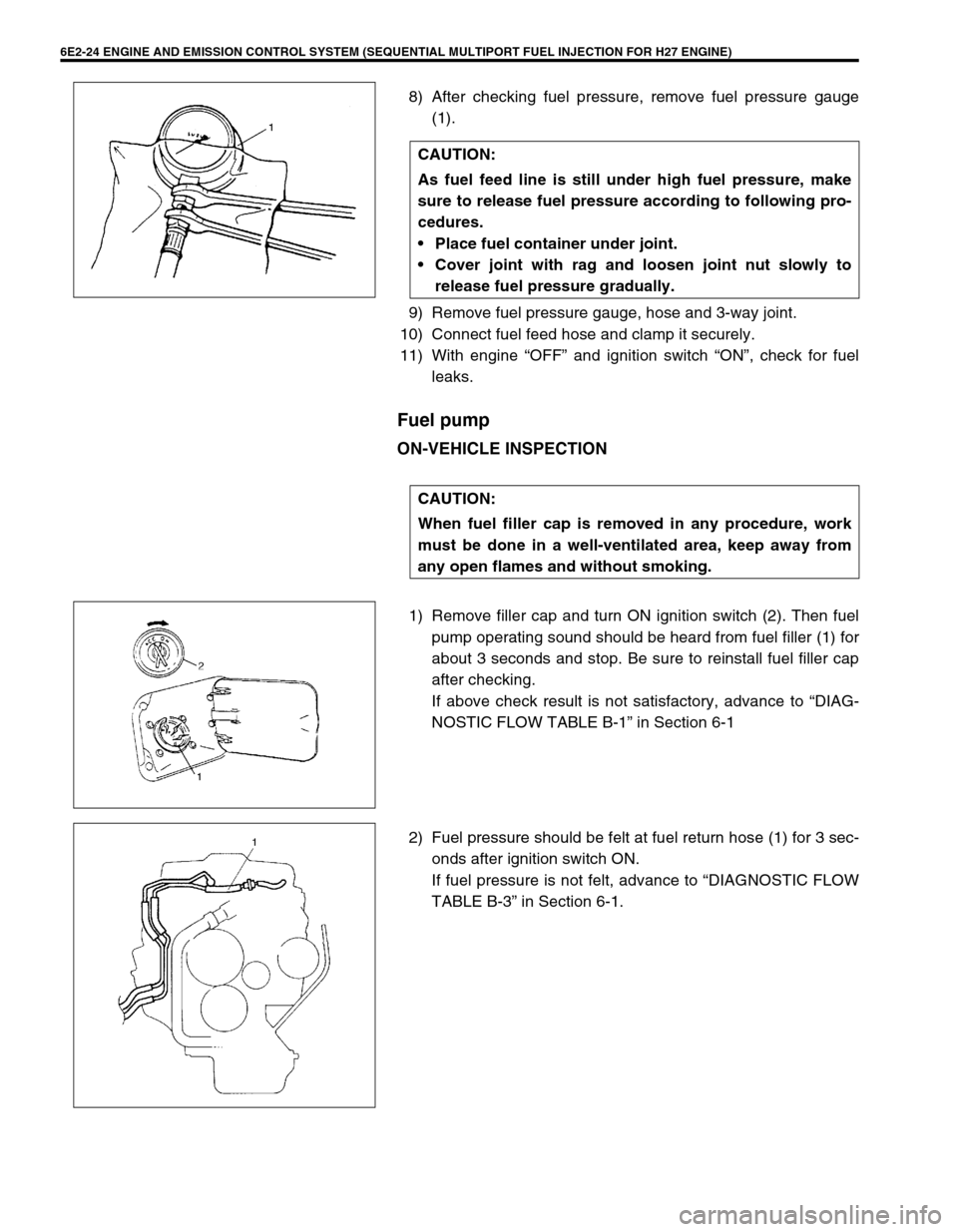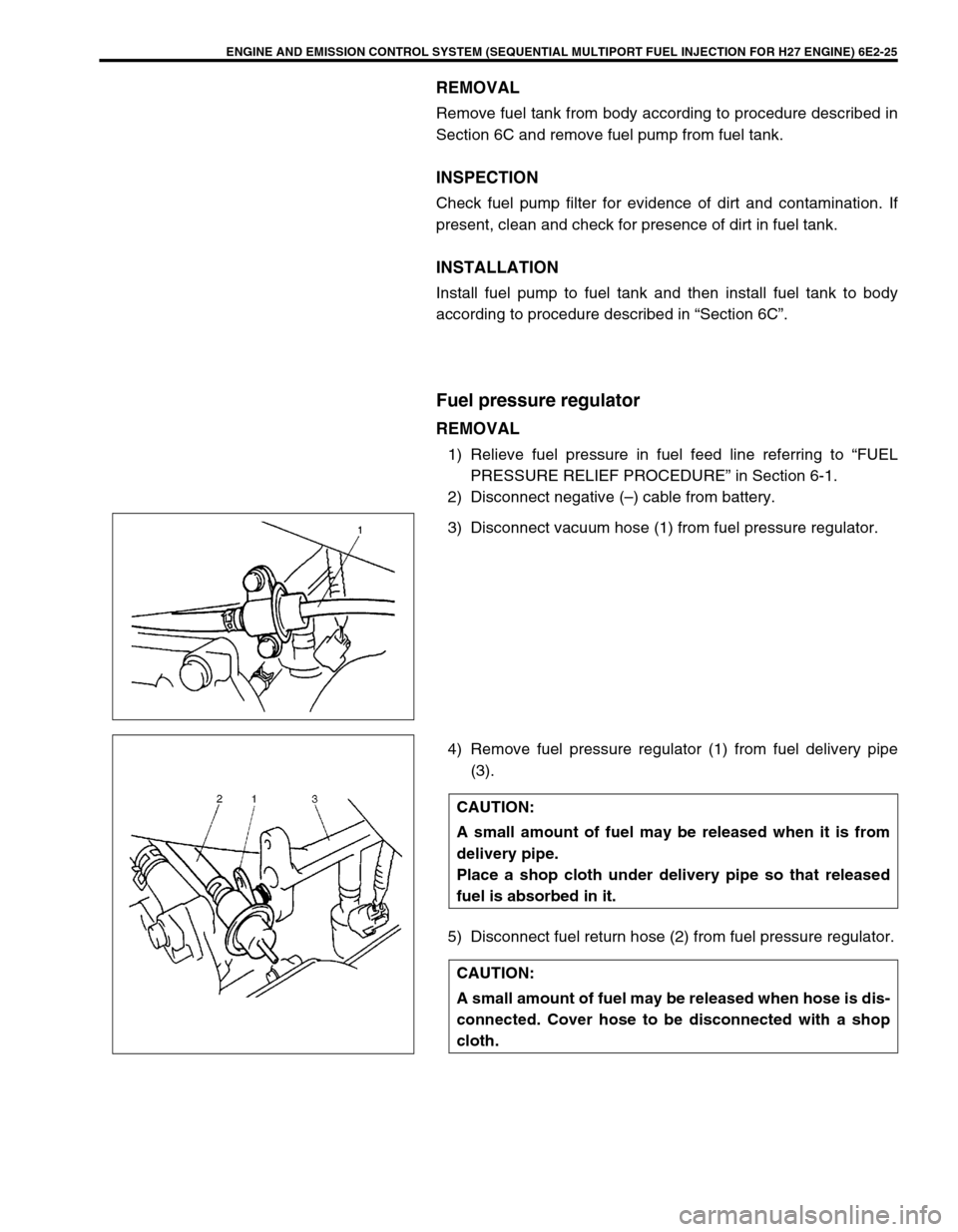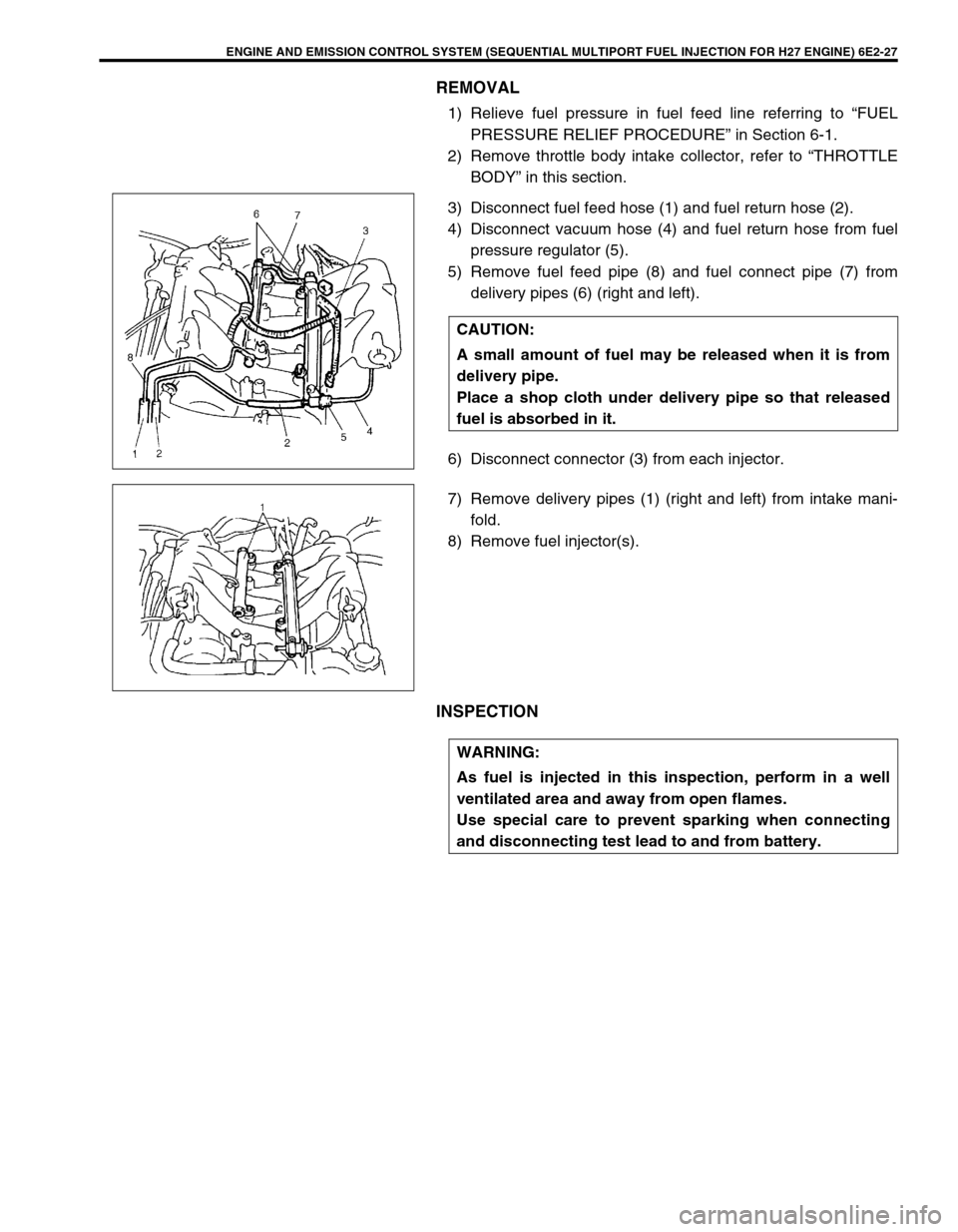Page 356 of 656

ENGINE AND EMISSION CONTROL SYSTEM (SEQUENTIAL MULTIPORT FUEL INJECTION FOR H27 ENGINE) 6E2-23
Fuel Delivery System
Fuel pressure inspection
1) Relieve fuel pressure in fuel feed line referring to “FUEL
PRESSURE RELIEF PROCEDURE” in Section 6-1.
2) Disconnect fuel feed hose from (3) delivery fuel feed pipe (1).
3) Connect special tools and hose (2) between fuel feed hose
and fuel feed pipe as shown in figure, and clamp hose
securely to ensure no leaks occur during checking.
Special tool
(A) : 09912-58441
(B) : 09912-58431
(C) : 09912-58490
4) Check that battery voltage is above 11 V.
5) Turn ignition switch ON to operate fuel pump and after 3 sec-
onds turn it OFF. Repeat this 3 or 4 times and then check
fuel pressure.
6) Start engine.
7) Measure fuel pressure at idling.
If measure pressure doesn’t satisfy specification, refer to
“Diagnostic Flow Table B-3” in Section 6-1 and check each
possibly defective part. Replace if found defective.
Fuel pressure specification: CAUTION:
A small amount of fuel may be released when fuel feed
hose is removed. Place container under the fuel feed
hose or fuel feed pipe with a shop cloth so that released
fuel is caught in container or absorbed in cloth. Place
that cloth in an approved container.
CONDITION FUEL PRESSURE
With fuel pump operating and
engine stopped270 – 310 kPa
2.7 – 3.1 kg/cm
2
38.4 – 44.0 psi
At specified idle speed 210 – 260 kPa
2.1 – 2.6 kg/cm
2
29.8 – 37.0 psi
With 1 min. after engine (fuel pump)
stop (Pressure reduces as time
passes)over 200 kPa
2.0 kg cm
2
28.4 psi
Page 357 of 656

6E2-24 ENGINE AND EMISSION CONTROL SYSTEM (SEQUENTIAL MULTIPORT FUEL INJECTION FOR H27 ENGINE)
8) After checking fuel pressure, remove fuel pressure gauge
(1).
9) Remove fuel pressure gauge, hose and 3-way joint.
10) Connect fuel feed hose and clamp it securely.
11) With engine “OFF” and ignition switch “ON”, check for fuel
leaks.
Fuel pump
ON-VEHICLE INSPECTION
1) Remove filler cap and turn ON ignition switch (2). Then fuel
pump operating sound should be heard from fuel filler (1) for
about 3 seconds and stop. Be sure to reinstall fuel filler cap
after checking.
If above check result is not satisfactory, advance to “DIAG-
NOSTIC FLOW TABLE B-1” in Section 6-1
2) Fuel pressure should be felt at fuel return hose (1) for 3 sec-
onds after ignition switch ON.
If fuel pressure is not felt, advance to “DIAGNOSTIC FLOW
TABLE B-3” in Section 6-1. CAUTION:
As fuel feed line is still under high fuel pressure, make
sure to release fuel pressure according to following pro-
cedures.
Place fuel container under joint.
Cover joint with rag and loosen joint nut slowly to
release fuel pressure gradually.
CAUTION:
When fuel filler cap is removed in any procedure, work
must be done in a well-ventilated area, keep away from
any open flames and without smoking.
Page 358 of 656

ENGINE AND EMISSION CONTROL SYSTEM (SEQUENTIAL MULTIPORT FUEL INJECTION FOR H27 ENGINE) 6E2-25
REMOVAL
Remove fuel tank from body according to procedure described in
Section 6C and remove fuel pump from fuel tank.
INSPECTION
Check fuel pump filter for evidence of dirt and contamination. If
present, clean and check for presence of dirt in fuel tank.
INSTALLATION
Install fuel pump to fuel tank and then install fuel tank to body
according to procedure described in “Section 6C”.
Fuel pressure regulator
REMOVAL
1) Relieve fuel pressure in fuel feed line referring to “FUEL
PRESSURE RELIEF PROCEDURE” in Section 6-1.
2) Disconnect negative (–) cable from battery.
3) Disconnect vacuum hose (1) from fuel pressure regulator.
4) Remove fuel pressure regulator (1) from fuel delivery pipe
(3).
5) Disconnect fuel return hose (2) from fuel pressure regulator.
CAUTION:
A small amount of fuel may be released when it is from
delivery pipe.
Place a shop cloth under delivery pipe so that released
fuel is absorbed in it.
CAUTION:
A small amount of fuel may be released when hose is dis-
connected. Cover hose to be disconnected with a shop
cloth.
Page 360 of 656

ENGINE AND EMISSION CONTROL SYSTEM (SEQUENTIAL MULTIPORT FUEL INJECTION FOR H27 ENGINE) 6E2-27
REMOVAL
1) Relieve fuel pressure in fuel feed line referring to “FUEL
PRESSURE RELIEF PROCEDURE” in Section 6-1.
2) Remove throttle body intake collector, refer to “THROTTLE
BODY” in this section.
3) Disconnect fuel feed hose (1) and fuel return hose (2).
4) Disconnect vacuum hose (4) and fuel return hose from fuel
pressure regulator (5).
5) Remove fuel feed pipe (8) and fuel connect pipe (7) from
delivery pipes (6) (right and left).
6) Disconnect connector (3) from each injector.
7) Remove delivery pipes (1) (right and left) from intake mani-
fold.
8) Remove fuel injector(s).
INSPECTION
CAUTION:
A small amount of fuel may be released when it is from
delivery pipe.
Place a shop cloth under delivery pipe so that released
fuel is absorbed in it.
WARNING:
As fuel is injected in this inspection, perform in a well
ventilated area and away from open flames.
Use special care to prevent sparking when connecting
and disconnecting test lead to and from battery.
Page 363 of 656
6E2-30 ENGINE AND EMISSION CONTROL SYSTEM (SEQUENTIAL MULTIPORT FUEL INJECTION FOR H27 ENGINE)
5) Install fuel connect pipe (1) and tighten union bolts to speci-
fied torque with new gaskets (3).
Tightening torque
Fuel connect pipe union bolt
(b) : 30 N·m (3.0 kg-m, 22.0 lb-ft)
6) Install fuel feed pipe (2) and tighten union bolt to specified
torque with new gaskets.
Tightening torque
Fuel feed pipe union bolt
(a) : 30 N·m (3.0 kg-m, 22.0 lb-ft)
7) Connect vacuum hose (5) and fuel return hose (4) to fuel
pressure regulator.
8) Connect fuel feed hose (1) and fuel return hose (2).
9) Connect connectors of injector wire (3) to injectors.
10) Install throttle body and intake collector, refer to “THROTTLE
BODY” in this section.
11) With engine “OFF” and ignition switch “ON”, check for fuel
leaks around fuel line connection.
Page 364 of 656
ENGINE AND EMISSION CONTROL SYSTEM (SEQUENTIAL MULTIPORT FUEL INJECTION FOR H27 ENGINE) 6E2-31
Electronic Control System
Engine control module (ECM)/powertrain control
module (PCM)
REMOVAL
1) Disconnect negative (–) cable from battery.
2) Disable air bag system (if equipped) referring to “DIS-
ABLING THE AIR BAG SYSTEM” in Section 10B.
3) Remove ECM (PCM) cover (1) from bracket.
4) Disconnect connectors from ECM (PCM) (1).
5) Remove ECM (PCM) (1) with bracket (2).
INSTALLATION
1) Install ECM (PCM) with bracket to vehicle.
2) Connect connectors to ECM (PCM) securely.
3) Install ECM (PCM) cover to bracket.
4) Enable air bag system (if equipped) referring to “ENABLING
AIR BAG SYSTEM” in Section 10B.
5) Connect negative (–) cable to battery. CAUTION:
As ECM (PCM) consists of precision parts, be careful not
to expose it to excessive shock.
Page 370 of 656

ENGINE AND EMISSION CONTROL SYSTEM (SEQUENTIAL MULTIPORT FUEL INJECTION FOR H27 ENGINE) 6E2-37
Heated oxygen sensor (sensor 1)
REMOVAL
1) Disconnect negative (–) cable from battery.
2) Disconnect coupler of oxygen sensor (s).
3) Remove oxygen sensor (s) from exhaust manifold (s).
INSTALLATION
Reverse removal procedure noting the followings.
•Tighten oxygen sensor (s) to specified torque.
Tightening torque
Heated oxygen sensor 1
(a) : 45 N·m (4.5 kg-m, 32.5 lb-ft)
•Connect connector of oxygen sensor (s) and clamp wire har-
ness securely.
•After installing oxygen sensor (s), start engine and check
that no exhaust gas leakage exists.
INSPECTION
Inspect HO2S-1 and its circuit referring to “DTC P0130 or P0150
Diag. Flow Table” in Section 6-1. If malfunction is found, replace. WARNING:
To avoid danger of being burned, do not touch exhaust
system when system is hot. Oxygen sensor removal
should be performed when system is cool.
NOTE:
Be careful not to expose it to excessive shock.
1. Left (No.1) bank oxygen sensor (sensor 1)
Page 372 of 656

ENGINE AND EMISSION CONTROL SYSTEM (SEQUENTIAL MULTIPORT FUEL INJECTION FOR H27 ENGINE) 6E2-39
HEATER INSPECTION
Refer to “HEATED OXYGEN SENSOR (SENSOR 1) HEATER
INSPECTION”
Vehicle speed sensor (VSS)
ON-VEHICLE INSPECTION
1) Hoist vehicle.
2) Release parking brake lever, set transmission in neutral and
transfer in “2H”.
3) Remove ECM (PCM) cover.
4) Connector voltmeter between VSS terminal C51-3-1 of ECM
(PCM) connector and body ground.
5) Turn ignition switch ON and turn rear right tire slowly with
rear left tire locked.
Voltmeter should indicate deflection between 0 – 1 V and 8 –
14 V a few times while tire (1) is turned one revolution.
If check result is not satisfactory, proceed to flow table of
“DTC P0500” in Section 6-1.
REMOVAL, INSPECTION AND INSTALLATION
Refer to “VSS Removal, Inspection or Installation” in Section 7D.
Manifold absolute pressure sensor
REMOVAL
1) Disconnect negative (–) cable at battery.
2) Disconnect connector from manifold absolute pressure sen-
sor.
3) Remove manifold absolute pressure sensor from intake
manifold.
[A]: Terminal arrangement of ECM (PCM) coupler
(viewed from harness side)
1. VSS